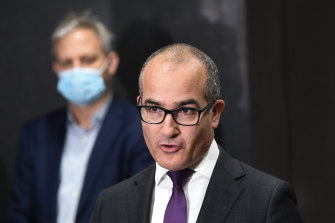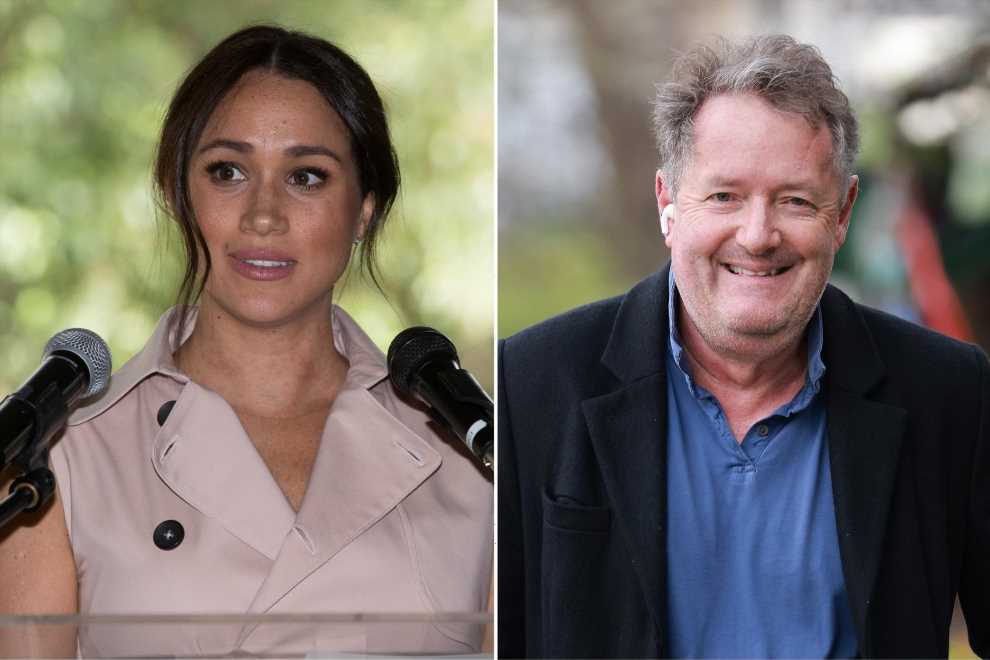For our free coronavirus pandemic coverage, learn more here.
Victoria’s Chief Health Officer, Brett Sutton, says that in a pandemic, a week feels like a billion years. For 20 days — an epidemiological eternity — the viral strain that prompted Victoria’s latest lockdown moved freely in our community, hidden from view.
A man who managed to travel through India without getting sick somehow came into contact with the virulent B.1.617.1 strain while quarantining in an Adelaide hotel room. Although he repeatedly tested negative for the virus, he was carrying it when he checked out on May 4, the day he flew home to Melbourne.
People queue to receive their COVID-19 vaccinations at Melbourne’s Royal Exhibition Building.Credit:Justin McManus
At the time, it looked as though this latest quarantine breach had done no harm. When the man became sick and tested positive, an intensive contract-tracing effort swung into action. The man didn’t infect any of the people who shared his Wollert home in Melbourne’s north, nor his workplace in Altona North. No further trace of infection was found at all.
We now know something was missed. That somehow the virus found a way. We don’t know where it spread. We don’t know who passed it on. We don’t know how far this outbreak had already spread by the time the next positive case was recorded on Monday.
But we do know that, although the problems with hotel quarantine are well established and contact tracing remains an imperfect science, we have ourselves to blame.
Outbreaks are inevitable, yet we put our trust in Fortress Australia. Vaccines became available, but there was no urgency to get one. The mixed message from government was we should get a jab if we wanted one but it was OK to wait. Supply was slow to arrive and the advice on AstraZeneca slowed things further.
The federal government wasn’t fussed about vaccine hesitancy. They thought it would sort itself out once more people got a jab. We were told how lucky we were not to be rushing out vaccines in the middle of a wave of new infections. Compared to nearly every developed nation, we were. Nonetheless, we were exposed, as the events of this week painfully show.
Nathan Grills, from the University of Melbourne’s Nossal Institute for Global Health, is one of many public health experts who warned this could happen and that greater urgency was needed in our vaccine program. As Victoria endures another damaging lockdown with businesses shut, school kids at home and potentially a second long COVID-19 winter ahead, he is dismayed to be proven right.
“You can’t cut yourself off completely from the world, it is just not feasible,” he tells The Age and The Sydney Morning Herald. “You can limit the cases coming back in but there are going to be outbreaks. And as you get more variants you are going to get more rapid spread of the virus, as we are seeing now.
“The idea of waiting until you see how everyone else fares is very individualistic. We vaccinate so it protects the wider community and the vulnerable who can’t be vaccinated. That seems to have been lost. It is about the common good.”
On the day the Victoria’s lockdown was announced, Victoria’s acting Premier James Merlino delivered a blunt message. Although it was principally directed at Canberra, it applies just as readily to anyone who is eligible to get a vaccine and doesn’t think they need one.
Acting Premier James Merlino and Chief Health Officer Brett Sutton announce the details of Victoria’s lockdown.Credit:Justin McManus
“We would not be in this position we are today, this necessary and difficult position that we are today, if our vaccination rates were much higher than they are today,” Merlino said. Health Minister Martin Foley described vaccines as “our only ticket out of this”.
Who do they need to convince?
Polling for The Age and The Sydney Morning Herald conducted by the Resolve Political Monitor and published at the start of this month provides the most comprehensive picture to date. The survey found that between 30 and 40 per cent of respondents were reluctant to get vaccinated.
Of those who expressed vaccine hesitancy, one in two were nervous about side effects, particularly blood clots associated with the AstraZeneca vaccine, and about a third said they were waiting for more people to be vaccinated before they decide. Roughly 20 per cent agreed with variants of an “I’m all right, Jack” theme; whether because of our closed borders or lack of COVID-19 cases or their own age and good health, they didn’t feel at risk from the virus.
Each of these reasons for hesitancy, whether reasonable or not, is self-centred. This is a departure from our usual approach to vaccination, where we inoculate babies against extremely rare diseases like whooping cough to ensure they remain extremely rare, and boys against papillomavirus even though they are at no risk of developing cervical cancer.
Stephen Duckett, the most senior health bureaucrat in the Kennett and Keating governments, wonders what happened to the community solidarity so evident in our adherence to public health directions during last year’s lockdown.
“The messaging should be not only is this about protecting ourselves, it’s about protecting our parents and grandparents and neighbours,” he says.
Duckett adds that the notion of Fortress Australia forever warding off the pandemic was a nonsense. “That has always been fallacious,” he says. “There has always been a risk of a breakout from hotel quarantine.”
In case there is any quibble about this, a team of New Zealand and Australian researchers led by University of Otago research fellow Leah Grout did the maths. They found that in the first year of the pandemic, there were 14 quarantine failures in Australian hotels. Quarantine failures — where the virus passes from a hotel guest to someone not restricted to quarantine — occur on average at the rate of once every 18,000 returned passengers. The breach rate is highest in Victoria and lowest in Western Australia. In New Zealand, it is higher still.
On these numbers, the risk of the virus leaking out of hotel quarantine is more than double the risk of an AstraZeneca vaccine causing a blood clot. Where one person has died in Australia from a blood clot caused by an AstraZeneca vaccine, more than 800 people died in last year’s second wave epidemic caused by a quarantine breach at two Melbourne hotels.
Grout says her paper, which has been submitted for peer review, adds to the mounting evidence that discrete quarantine units with natural ventilation are needed to prevent airborne transmission of the virus, particularly for people likely to be infected with new variants such as the one now circulating in Melbourne’s north. University of Melbourne epidemiologist Tony Blakely, a contributor to the paper, says the current approach to quarantine will “go down in history as the biggest policy fail by Australian and New Zealand governments”.
It is now clear there is strong consensus between Melbourne and Canberra on the need for another approach. In the absence of a breakdown in negotiations, a new purpose-built quarantine centre for high-risk cases will be approved for construction. It will most likely be built at Avalon Airport, the site initially proposed by airport operators Linfox and preferred by the Morrison government, rather than the Mickleham site identified by the Victorian government.
The politics at play in this issue are self-evident. Premier Daniel Andrews first pledged to build a new cabin-style quarantine centre, based on the successful Howard Springs facility in the Northern Territory which has recorded no quarantine breaches throughout the pandemic, in the middle of Victoria’s previous lockdown in February. Merlino used the latest outbreak from quarantine – from Adelaide’s Playford Hotel – to increase pressure on Canberra to commit to those arrangements.
The Prime Minister’s response was telling. Although Canberra was nonplussed when the Victorian government, on the eve of the federal budget, announced its plan for Canberra to fully fund the project, a team of senior bureaucrats quickly engaged with their Victorian counterparts.
Morrison’s comments this week that a facility could be built sooner than expected suggests planning is well advanced. The funding split remains a sticking point but as of Friday, the Victorian government has invited expressions of interest from builders.
A bigger, unanswered question is whether Victoria’s latest outbreak and resultant lockdown will jolt the state and perhaps the nation out of COVID-19 apathy.
Deakin University epidemiologist Catherine Bennett is hoping this is the case. “What we do know for sure is waiting just creates time for more and more of this,” she says. “Maybe this outbreak is the kick in the pants people need to realise that one of the really important parts in our defence is vaccine. That means vaccine coverage, not just individual choice.”
Professor Catherine Bennett, chair of epidemiology at Deakin University. Credit:Jason South
Images from Melbourne of long queues at testing and vaccination centres, of football games being played before empty stadiums and people wearing masks whenever they step out their front doors should paint a clear enough picture of the ongoing risks of this pandemic.
If you need another, consider that a man in his 70s who developed COVID-19 at the start of this week is now clinging to life on a ventilator in an intensive care unit. He could have walked into a vaccination centre and had an AstraZeneca shot at any time over the past four weeks. It might not have stopped him getting the virus, but it would almost certainly have stopped him getting seriously ill.
Mass vaccination, like a new quarantine centre, is not an overnight remedy. The latest data from Public Health England suggests that after an initial shot of either the AstraZeneca of Pfizer vaccine, you have 33 per cent protection against the Indian variant of COVID-19. It takes a second shot for your protection to increase to 60 per cent and 88 per cent respectively. This means the full public health benefit of someone being inoculated today may not be felt for months.
On the first day of Victoria’s lockdown, the national vaccination tally clicked past 4 million — a milestone the federal government originally pencilled in for March 1. Whether Australia will ever reach a high enough vaccination rate to approach herd immunity remains a moot point but, as Bennett argues, every vaccination helps.
“We may not get to a point that you would call herd immunity but every vaccination along the path to get there makes you more resilient as a population and reduces your need to have lockdowns and other things,” she says. “The virus might not die out but it is certainly much easier to chase and it doesn’t leave a trail of dead people behind it.”
The federal government’s failure to promote a strong, clear message on this is one of the mysteries of the pandemic. In the absence of such a message, physicians such as Nathan Grill have been frustrated by strict Therapeutic Goods Agency regulations which prohibit doctors and pharmacists from promoting prescription medicines, including vaccines, to consumers. The only way a GP can publicly endorse the vaccination program is through reference to the government’s health campaign materials.
The materials currently on offer discuss vaccination in prosaic terms and do nothing to engender enthusiasm for a vital public health cause. Opposition health spokesman Mark Butler says we must do better: “I don’t pretend to understand what the campaign should look like. I am not a behavioural psychologist, I don’t construct these campaigns. But we have a strong tradition of doing that and it should be a huge focus of the government.”
Since the first confirmed cases of community transmission in Melbourne’s north were reported on May 24, there has been a change of tone in Canberra. Chief Medical Officer Paul Kelly said the emerging cluster was a “stark reminder” of how quickly things could change in a pandemic and urged everyone eligible for a vaccine to get one.
Federal Health Minister Greg Hunt, responding to questions from The Age and the Herald, issued a blunt message. “If you catch COVID-19, you could die, it’s as simple as that,” he says. “I urge all eligible Australians to be vaccinated as soon as possible.”
This reframed message came with a kicker; the supply of an additional 40,000 doses of Pfizer to Victoria and a further 90,000 doses over the next six weeks. This enabled the Victorian government to expand its mass vaccination program to people in their 40s. It means the supply of vaccines, whether AstraZeneca or Pfizer, is no longer a drag on vaccination rates in the state.
The record number of people now lining up to get vaccinated suggests that, belatedly, we have woken to our folly. A question that could plague us for months is why we waited for the virus to slip under our door?
Start your day informed
Our Morning Edition newsletter is a curated guide to the most important and interesting stories, analysis and insights. Get it delivered to your inbox.
Most Viewed in National
From our partners
Source: Read Full Article





